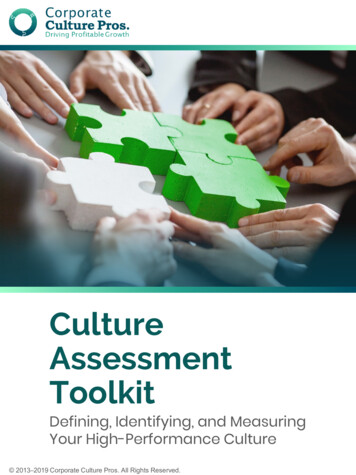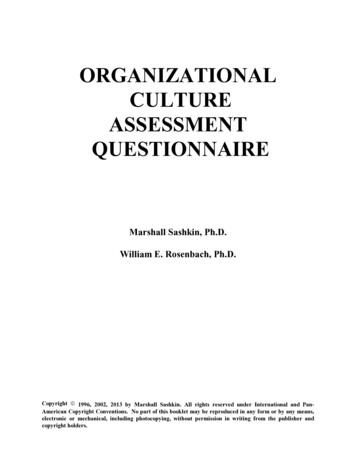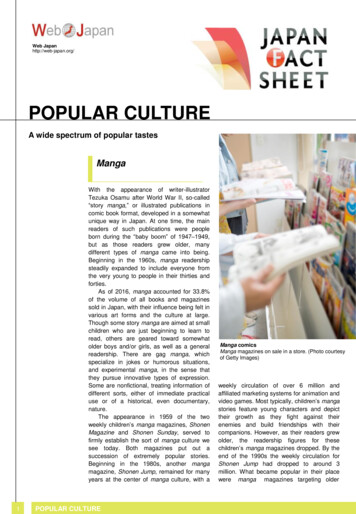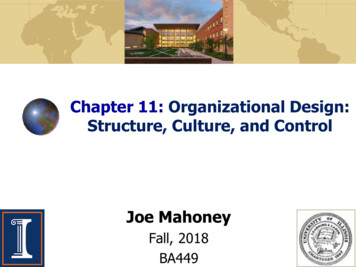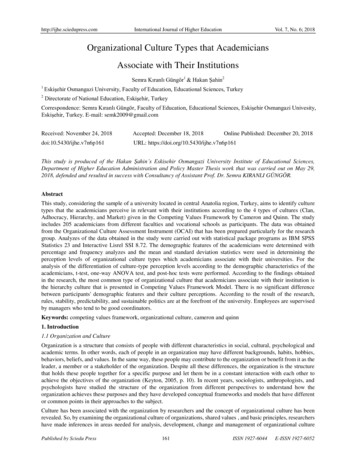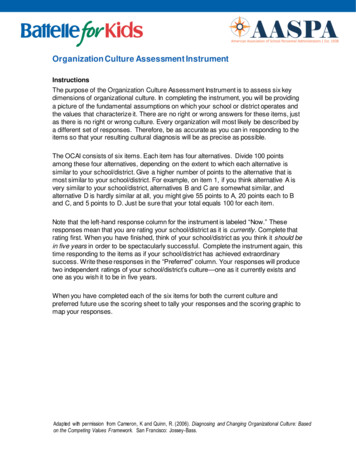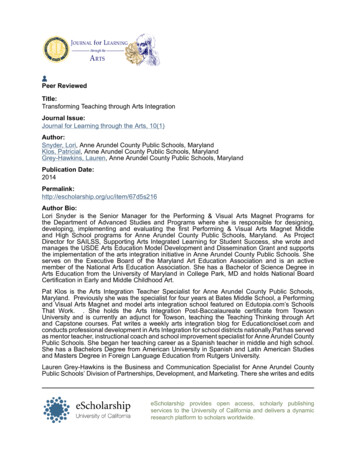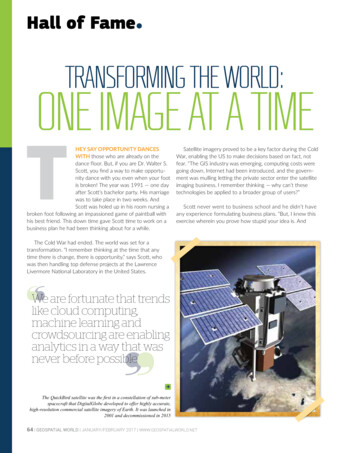
Transcription
Transforming Organizational Culture Assessment Tool (TOCA)Please read prior to using the Transforming Organizational Culture Assessment tool.The TOCA tool can be a helpful instrument for deepening internal organizational work on advancing racial equity, by specifically addressingwhite culture. First, please keep in mind that this is just a tool to use for a long change process. This tool’s purpose is NOT to diagnose anorganization, nor to provide statistical evidence of an organization’s capacity to work toward racial equity. This tool is an opportunity forindividuals within an organization to reflect on: a) the explicit use of terms in organizational documents; b) experiences and perspectives onhow race, racism and white privilege are discussed; and c) how policies and practices are aligning with the value of racial equity, specificallylooking at manifestations of white/dominant culture in organizational policies and practices.The impact on an organization when white dominant culture is not being addressed can include: A feeling among staff that they have limited freedom to offer different ideas in problem-solving, decision-making, etc. A focus on identifying individual mistakes rather than systemic challenges Decision-making with a lack of transparency and accountability Individuals within the organization holding back perspectives and insights, so not to cause conflict An internal communication processes which set up distinct groups of haves and have-nots for access to information A discussion about outcomes in which numbers trump other forms of dataExamples of internal work that organizations could adopt/continue as next steps: Reviewing organizational culture―that is, the unspoken and spoken rules and norms that guide behaviors in the organization―lookingfor examples of how white privilege and culture are manifesting. Reviewing policies and practices of the organization―identifying white privilege and entitlements in policies, practices, and culture, aswell as aligning practices with racial equity principles. Looking at the theory of change for program/strategies―that is, how strategies are expected to lead to results and the worldviewsand assumptions (spoken and unspoken) that undergird the program’s choice of strategies. Reviewing the program’s design, implementation and evaluation to understand how white privilege and culture may be manifesting.Take the example of a leadership development program:o Recruitment―Who is recruited? Who is involved in the decision-making process? Whose vote is privileged? Whatcharacteristics are being privileged for those candidates being defined as a “good” candidate?o Design―How are decisions being made about the program’s design? What assumptions are being made about the participants’needs? What is the level of involvement of past participants? How are past participants chosen to be involved with shaping thedesign?Transforming Organizational Culture Assessment Tool MP Associates Page 16/2016
oEvaluation―How are the outcomes of the program being tracked? Who is defining success? What and whose data is beingprioritized? Are the voices of graduates who shared a critique or lower ratings part of the evaluation discussion?As an assessment tool, TOCA can be used for discussion. The data collected can help organizations see and understand different points ofview and the impact of policies and practices on different stakeholders. Additionally, the results of this assessment can help individuals withinan organization to collectively create a roadmap―prioritizing what needs to be addressed and the strategies that need to be in place to makethat happen. Keep in mind that one characteristic of white culture is a need to resolve or fix something quickly (rather than spending timegetting to the root cause or seeing it from multiple perspectives to know if there is a problem).Please answer these questions prior to introducing the Transforming Organizational Culture Assessment tool:Does your organization have a common understanding of structural racism and white privilege? Are there individuals, including formal andinformal leaders, with conceptual understanding of structural racism and white privilege? It is important for the organization to have a common analysis ofstructural racism and racial equity, as well as an understanding of different terms (structural racism, white privilege, racial equity, etc.) in order to be ableto make full use of this tool. One training is not sufficient. There needs to be an ongoing commitment to build staff’s (and other stakeholders’, e.g.,volunteers’) knowledge and skills to talk about racism and white privilege, to identify interventions, etc. Without at least a basic shared understanding ofracism and white privilege, the tool can become a frustrating exercise that yields minimal or confusing dialogue and data.Has your organization made a commitment to work toward racial equity within the organization?Information collected from this tool will reveal people’s different perceptions about how the organization is doing in its efforts toward advancing racialequity. Prior to people sharing their perceptions and observations through this tool, it is important for the organization to commit to a process for reviewingthe information and addressing the concerns and barriers noted in the tool. Without this commitment, participants will be wary about answering candidly orwill doubt the usefulness of this exercise. One best practice is to create a working group focused on guiding a change process to align policies, practicesand culture with the values of diversity, inclusion and racial equity. This working group should be composed of staff with diverse identities, positions andperspectives, and who are committed to be leaders, messengers and catalysts in advancing racial equity within the organization (along with the leadershipof the organization).If your organization is not ready to use this tool yet, based on your responses to the two questions above, there are several resources that can assist youlocated on www.racialequitytools.org―please check out the Tipsheets as well as the sections on Organizational Change Process.Process for Using the Transforming Organizational Culture Assessment Tool: Prior to introducing the tool, create a plan of how the data will be reviewed, and a process for how the organization will be responsive tothe data and the stories shared. We recommend having a third party review and synthesize results, and work with formal and informalleaders to report the different perspectives back to the full team. Ideally, the third party should be knowledgeable about organizationalchange processes, racial equity and white culture.Transforming Organizational Culture Assessment Tool MP Associates Page 26/2016
It is critical for organizational members/employees to share their perceptions with full candor, and with no risk of consequences fromwithin the organization. People’s anonymity has to be preserved. While disaggregating data by race and gender generally can be helpful (in order to identify patterns that may be more noticeable orconsequential to those with marginalized identities), consider not disaggregating the data if there are relatively small numbers of aparticular gender and/or race within your organization. In that case, you may not want to collect demographic data unless a third party iskeeping the survey data confidential and disaggregating it before sharing with the organization.Also, note that this tool will not fit all organization types. TOCA was designed in the context of an organization with staff (mid to largeorganizations) and reflects non-profits more than other types of organizations. Therefore, modifications may need to be made so thequestions and the choices reflect your organization. Though the questions are geared more for staff, it would also be helpful to collectresponses with other groups who interact with your organization, e.g., board members, volunteers, and members and/or clients. We swim in white culture every day, and we each have different experiences in noticing its presence as well as its impact on ourorganizational culture. The Transforming Organizational Culture Assessment tool is meant to hold up a mirror to an organization’s policies andpractices. It is meant to provide a roadmap for what a racially equitable organization might look like. It is meant to assist in creatingbenchmarks for moving forward; and, it is meant to provide a vehicle for people to share their truth. Sometimes our process for movingtoward racial equity is to separate, assigning judgment on who is good or bad, and using tools as hammers rather than as catalysts forchange. I encourage you to remember “both and” as you move through this dynamic, exciting, frustrating, sometimes conflictual, andunifying change process for racial equity―remembering our accountability for our own personal role and behaviors, our linked fate, and ourcommitment to support each other through the process, and also the critical importance of holding to a steadfast belief in what is possible. Maggie Potapchuk, MP AssociatesJune, 2016Acknowledgements: There are several resources which informed the development of TOCA, including: Tema Okun – White Supremacy Culture, Judith Katz – SomeAspects and Assumptions of White Culture in the United States, Robette Ann Dias – Transforming Institutional Values: Revisited, Joseph Barndt – Understanding andDismantling Racism: The Twenty-First Century Challenge to White America, p. 234, Barbara Major – Chapter 7, “How does White Privilege Show Up in Foundation andCommunity Initiatives?”, from Flipping the Script: White Privilege and Community Building. My appreciation goes to several people who shared their insights on white culture,which also helped shape this tool―specifically, Sally Leiderman, Shakti Butler, Gita Gulati-Partee, Donna Bivens, A. Adar Ayira, Dottye Burt-Markowitz, Avis Ransom andDianne Lyday. Also, much gratitude to Gita Gulati-Partee, Scott Winn, Sally Leiderman, Jesse Villalobos, Alfredo Hernandez Corsen, Gail Harrison and Diane Goodman, whoreviewed the tool and generously made several suggestions and additions.Transforming Organizational Culture Assessment Tool MP Associates Page 36/2016
Transforming Organizational Culture Assessment ToolDemographics*:1. How do you describe your race? African American/Black Asian-American/Pacific Islander Hispanic/Latino/a Native American/Indigenous to Americas (e.g., Indio fromCentral America) Other:WhiteMultiracialArab/Persian/ Middle Eastern2. How do you describe your gender?FemaleMaleTransgender/Gender non-conformingOther (please specify):3. How do you describe your relationship with the organization?Upper ManagementMiddle ManagementEntry-levelBoard member4. How long have you been employed and/or affiliated with the organization?0-1 year 11-15 years2-5 years 16-20 years6-10 years More than 20 years Volunteer Community leader Other:*You may want to add a question to track departments and/or positions in the organization.Transforming Organizational Culture Assessment Tool MP Associates Page 46/2016
Organization Terms and Discourse5. This question will track perceptions about what terms are used by the organization by those with formal involvement with theorganization. In this chart, please indicate the extent to which you believe certain terms are part of various organizationaldocuments, using the numbers from the rating scale below. For example, if you believe that your organization’s website does notuse the term social justice, but does imply it based on the content shared, you would give the rating “2.” We recognize that you maynot be well-versed in the contents of all of these documents― your perception about whether a term is implicit or explicit is stillimportant. Full review can occur following the collection of the data.Please use the following ratings:0 Non-applicable―the document does not exist1 You don’t think the term is used in this particular document2 You think the term is not used but it is implied/implicit by the content shared3 You think the term might be mentioned in the document though it is not discussed4 You think the term is explicit in how it is shared―by explaining/making a case/substantive comment Example for a term being mentioned: “We also know that diversity in the workplace makes good management sense.”Example for a term being explicit: “We also know that diversity in the workplace makes good management sense; it promotes fairness, createsopportunities for communities of color and increases creativity.”TERMVision liciesOrganizationWebsiteAnnualReportMaterials toDonors (e.g., Newsletter)Theory ofChangeOutreachMaterialsRacial equityRacial justiceSocial justiceWhite privilegeStructural/ systemicracismRacial disparitiesCultural competenceDiversityInclusionEquityPlease share your comments and/or other details about the terms used and how these terms are discussed in the organization.Transforming Organizational Culture Assessment Tool MP Associates Page 56/2016
6. This question is designed to help you reflect on your experience with internal conversations and expectations in regards todiscussions about race, racism and white privilege in your organization.0 Unsure, 1 Strongly Disagree, 2 Disagree, 3 Agree, 4 Strongly AgreeTo what extent do you agree with the following statements:0123Talking about racism is encouraged in the organization.Talking about white privilege is encouraged in the organization.There is support for people who share their truth about racialized incidents at the organization.If someone raises issues about racism, the person can be marginalized.If someone raises issues about white privilege, the person can be marginalized.Giving feedback about a comment made or attitude about race/rac
Transforming Organizational Culture Assessment Tool MP Associates Page 1 6/2016 Transforming Organizational Culture Assessment Tool (TOCA) Please read prior to using the Transforming Organizational Culture Assessment tool. The TOCA tool can be a helpful instrument for deepening internal organizational work on advancing racial equity, by specifically addressing white culture. First,
